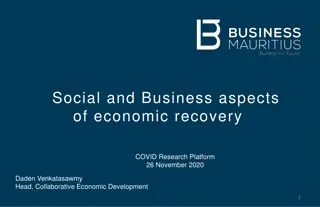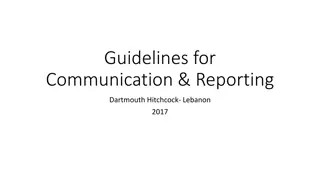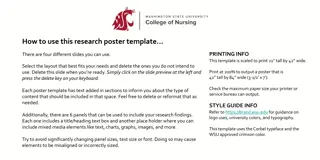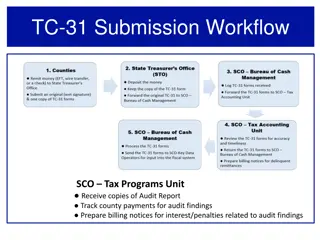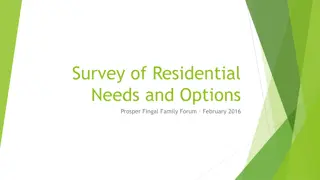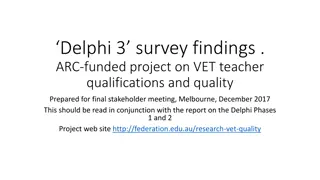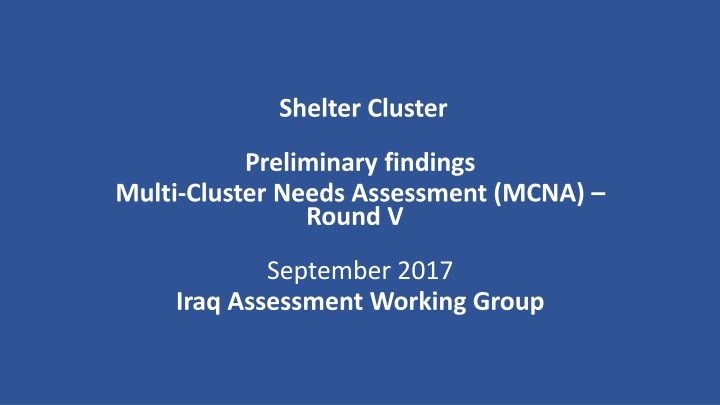
Preliminary Findings of Shelter Cluster Multi-Cluster Needs Assessment in Iraq
Explore the key objectives, methodology, partner collaboration, primary data collection, and preliminary findings of the Shelter Cluster Multi-Cluster Needs Assessment in Iraq. Gain insights into the process overview and next steps for addressing the needs of various population groups affected by displacement and conflict.
Download Presentation

Please find below an Image/Link to download the presentation.
The content on the website is provided AS IS for your information and personal use only. It may not be sold, licensed, or shared on other websites without obtaining consent from the author. If you encounter any issues during the download, it is possible that the publisher has removed the file from their server.
You are allowed to download the files provided on this website for personal or commercial use, subject to the condition that they are used lawfully. All files are the property of their respective owners.
The content on the website is provided AS IS for your information and personal use only. It may not be sold, licensed, or shared on other websites without obtaining consent from the author.
E N D
Presentation Transcript
Shelter Cluster Preliminary findings Multi-Cluster Needs Assessment (MCNA) Round V September 2017 Iraq Assessment Working Group
Overview of Presentation 1. OBJECTIVES & OVERVIEW 2. PROCESS OVERVIEW 3. METHODOLOGY 4. PARTNER COLLABORATION 5. PRIMARY DATA COLLECTION 6. PRELIMINARY FINDINGS 7. NEXT STEPS
OBJECTIVES & OVERVIEW 1. Presentation to AWG on 17th July explaining the objectives and methodology of the MCNA V as well as timeline for dissemination of preliminary findings, in line with the HNO/HRP timeframe. 2. Key Affected Population groups: IDPs in camps IDPs out of camps IDPs in informal sites Returnees Non-displaced remaining in recently retaken areas changed to: Non-displaced in newly accessible and conflict areas Host communities in high IDP density areas 3. AWG presentation on 17th July also launched the indicator review process. MCNAs are specifically aligned with the HNO/HRP process to inform multi-cluster programming. All clusters consulted on indicators. Feedback received on indicators; harmonization conducted 4. Methodology: Original methodology later adapted in line with HNO/HRP humanitarian profile e.g. Assessment of Non-displaced in newly accessible and conflict areas. MCNA V data to support people in need calculation at cluster level.
MCNA to HRP: Process Overview Research design Indicators, forming the basis of the survey tool, are reviewed at the cluster and ICCG level. Time: 1 - 31 July Validation and Dissemination Data collection Final output and cluster-specific findings shared with clusters/GBWS, while final report is shared for validation by ICCG and HCT. Data is collected directly by REACH and partners. Regular updates are provided to clusters. Time: 20 -30 Sept Time: 1 31 August Analysis & Preliminary findings presentation Final Analysis Cluster feedback informs in-depth analysis tailored to cluster-specific needs and triangulation of data ahead of Joint Assessment Workshop (ICCG). Preliminary findings presentations delivered bilaterally with clusters. Time: 11- 20 September Time: 1 - 14 September
Methodology overview Mixed methodology Secondary data review of existing datasets Household-level Data Collection in all fully directly accessible districts:representative samples of households from accessible areas Community-level Data Collection in not fully directly accessibleareas: purposively selected key informants from sampled locations in not fully accessible districts
Methodology Table 1: Population group overview 5. Non-displaced in newly accessible and conflict areas 1. IDP families in camps 2. IDP families outside camps 2.a IDP families in informal sites 3. Host community families GROUP 4. Returnee families REACH: MCNA V Primary data collection REACH: MCNA V Primary data collection *PARTNERS: MCNA V Primary data collection REACH Camp profile VIII REACH MCNA IV REACH Informal Site Assessment / RASP Data set Data collection date May 2017 April/May 2017 Feb/May 2017 August 2017 August 2017 August 2017 District level (of accessible districts) Yes, with 90% confidence level / 10% error margin National level (High IDP density locations) District level Yes, to achieve 95% confidence level / 5% error margin Data representative at Camp/District level Household interviews (directly accessible districts) Key informant interviews (non- accessible districts) Site level District level Yes, with 95% confidence level / 10% error margin Yes, to achieve 90% confidence level / 10% error margin No No No Yes No Yes Yes The assessment was implemented nationwide through a mixed methods approach, consisting of: Secondary data analysis of existing datasets on IDPs living in camps, informal sites, and in host communities Secondary data review of other relevant data/reports Statistically representative household survey administered in fully directly accessible districts Key informant interviews administered in districts that are not fully directly accessible (Direct, remote via phone and in hard to reach areas, newly displaced families from those locations) *Data collected by CAOFSIR, RNVDO, WFP, and Mercy Hands
Partner Collaboration Data collection conducted by: Canadian Aid Organization for International Society Rehab (CAOFISR) Mercy Hands for Humanitarian Aid Representative of Ninewa Voluntary for IDP (RNVDO) World Food Programme (WFP) Iraq REACH Secondary data review by: ACAPS (forthcoming)
Preliminary findings: Education 1. Household-level data is representative and consists of Returnees (95/10 at district level); IDPs out of camps (90/10 at district level); IDPs living in camps (95/10 at district level); and Host community families (95/5 at national level). Community-level data provided alongside HH data is indicative. Household-level analysis for each indicator is structured as follows: 2. 3. a) National level b) By population group (IDPs, returnees etc) Table 2: Population groups assessed at household level IDP families outside camps IDP families in camps Host community families Returnee families Camp/Governorate level District level (of accessible districts) National level (High IDP density locations) District level 95% confidence level 90% confidence level 95% confidence level 90% confidence level 10% error margin 10% error margin 5% error margin 10% error margin
Preliminary findings: Community level coverage What areas are covered by the community level assessments? Districts where direct household data collection could not be conducted, KI interviews were conducted by REACH and partners (partner collaboration). Table 3: Newly accessible & conflict areas (x 6 districts) Table 4: Returnees (hard to reach) (x 17 districts) Governorate Anbar District Fallujah, Haditha and Heet Governorate District Haditha Anbar Abu Ghraib Baghdad Kirkuk Kirkuk Hawiga Kirkuk Hamdaniya, Mosul, Sinjar, Telafar and Tilkaif Ninewa Baaj, Mosul and Telafar Ninewa Baiji, Balad, Daur, Samarra, Shirqat, Tikrit and Tooz Salah-al Din Shirqat Salah al Din
Settlement type (Direct Access / Household level) Residential housing was the most frequently reported settlement type in which households reside across all applicable population groups. 95% of host community households reported residing in residential housing, followed by 72% of returnee households, and 69% of out-of-camp IDP households. Collective centre is second most frequently reported settlement type, with returnees reporting highest occupancy (28%), followed by out-of-camp IDPs (20%). 11% of out-of-camp IDPs are reportedly living in informal sites. Table 5: Settlement type, by population group Residential housing Population group Collective center Informal site Transit site 5% 0% 95% 0% Host community / direct access 20% 11% 69% 0% IDPs (out of camp) / direct access 28% 0% 72% 0% Returnee / direct access
Settlement type (Restricted Access / Community level) As with household level findings, residential housing is the most frequently reported settlement type. However there is significant difference where non-displaced communities in newly accessible and conflict areas* reported residential housing more frequently (71%) than the returnee population (43%). Results for informal site were similar between returnee and non-displaced (20% and 18% respectively), but the proportion of returnees residing in collective centres was reported higher by returnees (20%) as was transit site (17%). Figure 1: Settlement type by population group 71% 43% 20% 20% 18% 16% 9% 2% Residential housing Informal site Collective center Transit site Non-displaced /restricted access Returnee / restricted access *This population group will be referred to as "non-displaced' throughout the remainder of this presentation.
Shelter type (Direct Access / Household level) In line with settlement type findings, across population groups house (residential housing) was the most frequently reported shelter type. Returnee and host community population groups reported this at 97% and 99% respectively. IDPs out of camps reported low occupancy in the house category (73%), but occupied other shelter types such as religious building (10%), apartment (7%), and unfinished building (6%). Across the applicable population groups, 19% of IDPs out of camps reside in critical shelters* (19%) in contrast to 1% of returnee and 0% for host community. Table 6: Shelter type by population group Religious building Unfinished building Abandoned building Damaged building Public building House Apartment Container School Tent Other Host community / direct access 97% 0% 3% 0% 0% 0% 0% 0% 0% 0% 0% IDPs (out of camp) / direct access Returnee / direct access 73% 10% 7% 6% 1% 1% 1% 1% 1% 1% 1% 99% 0% 0% 0% 0% 0% 1% 0% 0% 0% 0% *critical shelter is defined as public spaces such as religious centres and schools as well as unfinished and/or abandoned buildings.
Shelter type (Restricted Access / Community level) The vast majority of returnee communities reported to be residing in houses (94%), whereas a lesser majority of non-displaced communities reported so (77%). A significant minority of non-displaced communities reported residing in tents (15%) and 4% in containers compaed with returnees who reported 0% for both these categories. Returnees reported higher for residing in critical shelters (5%) when compared to non-displaced communities (1%). Figure 2: : Shelter type by population group 94% 77% 15% 4% 3% 2% 1% 1% 1% 1% 0% 0% 0% 0% 0% 0% House Tent Container Unfinished building damaged building Apartment Nothing else Public building Returnee / restricted access Non-displaced /restricted access
Type of shelter occupancy (Direct Access / Household level) Returnee households most frequently reported owning their property (88%), followed by host community households (75%). Less than 10% of returnees are renting compared with 21% for host community and 72% for IDPs out of camps. IDPs out of camps were not residing in shelters belonging to them and were either renting (72%) or squatting (26%). Table 7: Type of shelter occupancy by population group Hosted Own Renting Squatted Other Host community /direct access IDPs (out of camps) / direct access 0% 75% 21% 3% 1% 1% 1% 72% 26% 0% Returnee / direct access 1% 88% 9% 2% 0%
Priority needs (Direct Access / Household level) Households were asked to prioritise 3 needs from a list of options. Food was the highest reported need for IDPs in camps (71%), IDPs out of camps (62%) and returnees (60%). Host community households reported medical care as the top priority need (55%). IDPs out of camps reported shelter needs at a higher proportion (23%) when compared to other population groups. Population group reporting the lowest proportion of shelter support is returnee (5%). Table 13: Reported priority needs by population group (3 options) Documentati on Psychosocial support Vocational training Education Employment Food Medical care Shelter support Water Registration Sanitation Host community /direct access 0% 9% 41% 50% 55% 21% 6% 17% 2% 8% 10% IDPs (in camps) /direct access 3% 10% 54% 71% 24% 3% 14% 7% 2% 4% 1% IDPs (out of camps) /direct access 1% 20% 48% 62% 37% 6% 23% 8% 3% 5% 3% Returnee /direct access 1% 21% 34% 60% 56% 15% 5% 25% 9% 5% 4%
Rented accommodation (Direct Access / Household level)* For those households reporting being behind on rent (7% for returnees and 4% for host community), host communities reported higher in the one month category (67%) compared to returnee (17%). 50% of returnees reported being behind with rent for 2 months. Both population groups have the same proportion of HHs who are behind rent for over 3 months. 22% of returnees had contracts for less than 3 months compared to 2% for host community. 63% of the host community population reported having rental contracts that were more than 6 months compared to returnees, who reported this at 52%. Table 8 : Number of months in arrears by population group Table 9: Length of rental agreement by population group 2% 10% 3 months 4-6 months 67% 1 month Host community / direct access Host community / direct access 0% 2 months 63% Over 6 months 33% 3 to 8 months 25% Contract no length 22% 7% 3 months 4-6 months 17% 1 month Returnee / direct access 50% 2 months Returnee / direct access 52% Over 6 months 33% 3 to 8 months 19% Contract no length *New sub-set indicator introduced during MCNA V (does not include IDPs out of camps)
Shelter assistance received (Direct Access / Household level) Across population groups between 80-97% of households reported not receiving any form of shelter assistance in the six months preceding data collection. Results indicate that 20% of IDPs out of camps and 14% of returnees had received shelter assistance. Most frequently reported assistance included rental support by IDPs out of camps and tarpaulin by returnees (both 9%). Table 10: Breakdown of population groups reporting shelter assistance received Sun shading net Electric connection Rental support Tent Tarpaulin Timber Door Window Wash Nothing Other Host community /direct access 2% 0% 1% 0% 0% 0% 0% 0% 0% 97% 0% IDPs (out of camps) / direct access 9% 1% 7% 3% 2% 2% 3% 3% 1% 80% 1% Returnee /direct access 0% 2% 9% 3% 0% 2% 1% 1% 0% 86% 1%
Shelter assistance received (Restricted Access / Community level) Across both population groups, 71% of communities reported not receiving any type of shelter assistance in the six months preceding data collection. Compared to non-displaced population, returnees reported receiving low-cost shelter assistance such as electrical connection (5%), doors (4%) and windows (1%) whereas non-displaced reported 0% across these categories. Table 11: Shelter assistance received, by population group Nothing else reported Electric connection Sun shading net Nothing Tent Door Tarpaulin Timber Rental support Other Window Returnees/ restricted access 70% 7% 7% 4% 5% 2% 1% 1% 1% 1% 1% 71% 15% 10% 0% 0% 1% 1% 1% 0% 0% 0% Non-displaced / restricted access
Shelter issues (Direct Access / Household level) Broken windows, leaking roof and damp were the most reported shelter issues across population groups. Returnees reported highest for these issues: broken windows (70%), leaking roof (70%) and damp (63%). IDPs out of camps reported a wider range of issues in comparision to host communites (12 out of the 13 categories compared with 6 out of 13 categories for host community). This indicates that IDPs out of camps are living in more vulnerable shelters when compared to the other population groups; over crowding (31%), lack of heating (26%) and without electrical connection (20%). Table 12: Reported shelter issues by population group IDPs (out of camps) / direct access Host community / direct access Returnee/ direct access 40% 50% 20% 0% 0% 0% 20% 0% 37% 48% 53% 26% 14% 6% 28% 9% 70% 70% 63% 0% 0% 0% 18% 13% Broken windows Leaking roof Damp Lack of heating Unhygienic Lack of lighting Lack of privacy Not secure 0% 30% 10% 0% 0% 20% 37% 0% 31% 2% 3% 18% 20% 5% 3% No electrical connection Vectors Cracked Too small Other
Priority needs as reported at community level Communities were asked to prioritise 3 needs from a list of options. For returnees, employment was the highest reported need (68%) followed by medical care (66%) and food (61%). For non-displaced, food was the highest reported need (60%), followed by medical care (54%) and employment (52%). Similar to household level, at the community level shelter support was not prioritized as highly as the other basic needs. Table 14: Reported priority needs by population group (3 options) Documentat ion Medical care Psychosoci al support Shelter support Vocational training Education Employment Food Water Registration Sanitation Returnee / direct access 2% 40% 68% 61% 66% 10% 2% 27% 4% 1% 2% Non- displaced / direct access 13% 18% 52% 60% 54% 5% 4% 35% 8% 5% 0%
MCNA V: Next Steps 1. Feedback on preliminary findings To feed into Joint Assessment Workshop (20 September 2017) including areas of interest and level of detail. Informing of Humanitarian Needs Overview (People in Need figures). Access to final, cleaned dataset. 2. Finalisation and sign off Finalisation of report and other outputs (cluster-level hand outs and maps) (October 2017) Presentation of lessons learned (ICCG meeting) (TBC).




